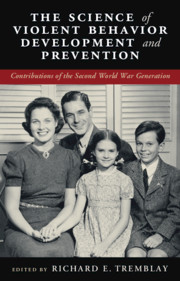 The Science of Violent Behavior Development and Prevention
The Science of Violent Behavior Development and Prevention Published online by Cambridge University Press: 28 January 2021
Six younger investigators of violent behavior comment on the autobiographies of their senior colleagues. They were chosen to represent investigators at different points in their careers, as well as different countries and different topics. Their comments highlight the family, economic, cultural, and professional contexts that influenced the lives and careers of their senior colleagues. They also highlight the general lessons to be learned from their research. They then describe how the last five decades of work has set the agenda for the next generations of scholars. Suggested future research topics include: 1) testing the extent to which reducing identified risk factors has preventive impacts; 2) studying genetics and epigenetics; 3) using machine learning; 4) using electronic tools to substantially increase data collection in longitudinal studies; 5) expanding the education and training of aggression researchers by integrating biological sciences, data sciences such as bioinformatics and machine learning, social sciences, moral sciences, and the art of policymaking; 6) creating international research teams to do cross-cultural studies and also address global violence research; and 7) scaling up evidence-based programs for wider dissemination and to achieve population-level impacts.
To save this book to your Kindle, first ensure [email protected] is added to your Approved Personal Document E-mail List under your Personal Document Settings on the Manage Your Content and Devices page of your Amazon account. Then enter the ‘name’ part of your Kindle email address below. Find out more about saving to your Kindle.
Note you can select to save to either the @free.kindle.com or @kindle.com variations. ‘@free.kindle.com’ emails are free but can only be saved to your device when it is connected to wi-fi. ‘@kindle.com’ emails can be delivered even when you are not connected to wi-fi, but note that service fees apply.
Find out more about the Kindle Personal Document Service.
To save content items to your account, please confirm that you agree to abide by our usage policies. If this is the first time you use this feature, you will be asked to authorise Cambridge Core to connect with your account. Find out more about saving content to Dropbox.
To save content items to your account, please confirm that you agree to abide by our usage policies. If this is the first time you use this feature, you will be asked to authorise Cambridge Core to connect with your account. Find out more about saving content to Google Drive.